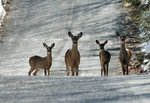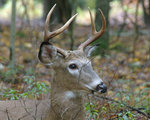With the arrival of fall comes the movement of many animals—birds are migrating, reptiles and amphibians that are still out are headed to winter hibernation spots, and many mammals are gathering mass or bulking up for the lean winter.
Stay informed about your community and support local independent journalism.
Subscribe to The River Reporter today. click here
This item is available in full to subscribers.
Please log in to continue |


With the arrival of fall comes the movement of many animals—birds are migrating, reptiles and amphibians that are still out are headed to winter hibernation spots, and many mammals are gathering mass or bulking up for the lean winter.
One mammal in the area is active for another reason.
Deer get more active in the fall due to their annual rut (breeding season). Male bucks are seeking females to mate with during this time of year. Bucks competing for the right to mate with females can sometimes be spotted sparring in the woods, usually with their antlers locked together. Sometimes the antlers of a pair of bucks can become hopelessly entangled with each other, and it requires human intervention to separate the antlers and free the combative deer.
The male deer can get aggressive towards other male deer, and they can be drawn into an area by the sounds of buck grunts, or the clashing of antlers of another sparring pair of bucks. They seem to not pay attention to other things, and for this reason, they can be a hazard to themselves and us when near roads. Deer might cross the road with little or no warning, frequently at speed.
Aside from the rut itself, hunting season has started for bow hunters, and rifle season will start soon. Hunters going into the woods usually cause deer to move from their usual habitats and across roads.
A press release from the PA Game Commission (PGC) states that the state has led the nation in reported vehicle-vs.-animal collisions during the past year. Most of the animals involved in these statistics are deer.
Though there are a lot of deer around, there are some recommendations from the PGC and other agencies to reduce unwanted encounters with deer.
Drive at reasonable speeds; a slower speed means you will have more time to stop if a deer jumps in front of you from behind brush, berm or other defilades.
If you see one deer cross in front of you, be cautious; there may be more behind it. Deer tend to cross roads in a column.
If you see a deer and can’t stop in time, it’s usually too late to veer; that could cause you to hit a tree or oncoming vehicle, which is a far worse outcome than hitting the deer.
You might be able to harvest the animal if you hit it; contact your state wildlife agency on the particulars, and to get any permits required.
If a deer is injured and still alive, keep your distance; a hurt animal is usually panicked, and can injure you with antlers or hooves.
Call your state wildlife agency or other law enforcement agency if you think the deer needs to be put down.
When looking for vehicle damage, look for any deer hair, etc., on the vehicle; take a picture of the hair and give it to your insurance company. Hitting an animal is usually not an “at-fault” accident.
Use extra care on the road this fall, and hopefully the only deer you bag this year will be out in the field if you’re a hunter. A day out in the woods in the fall is much less aggravating than an unplanned visit to the body shop.
Comments
No comments on this item Please log in to comment by clicking here